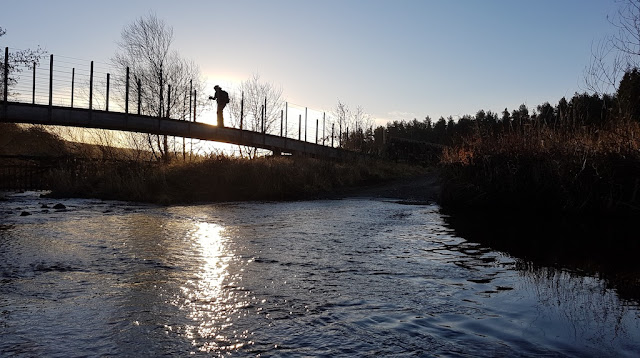Written by Jasmin Paris - https://jasminfellrunner.blogspot.com/
It’s taken me almost a year to sit down and write this, my account of running the Montane Spine Race 2019. Since then I’ve done countless interviews for all sorts of sources, and I could answer their standard questions in my sleep. Yet I feel there is more to tell, at least for those genuinely interested, so here’s my story.
The Spine is a 268-mile long race run along the Pennine Way, starting from Edale in the south and finishing at Kirk Yetholm in the north. Checkpoints along the way are roughly 40 to 50 miles apart - between them runners are reliant on their own food supplies and navigational abilities, as the race route is not specifically marked. Critically, the race is run in mid-January, when winter weather conditions and limited daylight hours conspire to thwart progress and weaken resolve. In a final twist, the race is non-stop, with competitors having 7 days to make the journey – which means that sleep is a highly tactical aspect, too much and you’ll drop places, too little and you’ll drop out.
The fact that I signed up to race the Spine was in itself something of an irony. I’d followed the race for many years, and had crossed paths with the runners whilst racing ‘Trigger’ (from Marsden to Edale) on several occasions, always noting their large packs, and slow-moving forms, braced against the wind with 250+ miles still to go… After these encounters, I’d pronounce decidedly ‘One would have to be crazy to run that race, what suffering it must entail!’. Yet I suppose that a part of me must have been intrigued, by precisely that – the challenge of a race I wasn’t sure I could finish, at least not in a racing capacity.
In September 2018, I finished my season with a second place at the Ben Nevis race, thus winning the British Fellrunning Championships series 9 months after giving birth to our baby girl Rowan. Whilst I was proud of this comeback, I was also very aware that I wasn’t back to my previous racing form. Moreover, I was finding it harder to motivate myself to train, at 5am before work, after a broken night of sleep, especially with the coming of winter darkness. So I did two things; I signed up for the Montane Spine Race 2019 - a race whose concept and reputation was crazy enough to inspire me, and for the first time in my running career I enlisted the help of a coach – Damian Hall – who provided the perfect structure and accountability to maximise the potential of the limited free time I had available to train.
Training
I trained every day from October to January in the early hours before dawn by the light of a headtorch, mostly in the Pentland and Moorfoot Hills, which are a little south of Edinburgh. Since my time was limited, weekday runs were capped at 1.5 hours maximum, and combined weekend runs amounted to around 10 hours. My weekly schedule was roughly 2-3 harder sessions (for example one speed session, one session of hill repeats, and one tempo/fartlek run), 2-3 ‘recovery’ runs, and two longer runs, one of which might involve some faster running. I did my best to fit in with our family plans, so my Saturday long run was often a loop across the Moorfoot hills to our local parkrun, where I would finish with a fast 5km pushing Rowan in the buggy, whilst Konrad raced for real. My mileage increased gradually, from around 50 miles a week in October, to 100 miles over the New Year, in a week that included 3 back-to-back long runs of 5-6 hours each. With the exception of the speed sessions, I ran everything with a pack, increasing the weight gradually from 1kg to around 6kg by January. Whilst I tried to practice race nutrition on long runs, I wasn’t convinced it was very helpful, since eating is rarely a problem for me until around 8-10 hours into a race. With the exception of the Cheviot Goat race in December, I didn’t do any recce runs on the Pennine Way itself, although I had vague memories of the route from running it with Konrad in November 2014 (on that occasion we ran from north to south, staying in B&Bs every night and enjoying slap-up evening meals and breakfasts; it took us 6 ½ days in total). To augment the running, I did some strength training (although not as conscientiously as I should have), and swimming (although much less than in my pre-baby days). In retrospect, I suppose I also trained the sleep deprivation aspect of the race – not by choice I should add – because Rowan was still waking up every 2-3 hours during the night at the time.
Final preparations
In the final days before the race I felt reasonably confident in my training and resulting physical fitness. Of a greater concern to me was the thought of leaving my family for up to a week, in particular because - in spite of my intention for her to be weaned by January – Rowan was still breastfeeding at regular intervals as the race day approached. Knowing that I didn’t want to force the matter (at 13 months she no longer really needed breastmilk and rarely asked for it when I wasn’t there, but it was an important part of our relationship), I made sure there was a sufficient supply of frozen expressed breast milk in the freezer to cover my absence, and resigned myself to pumping at checkpoints (mastitis on the Spine was the last thing I needed).
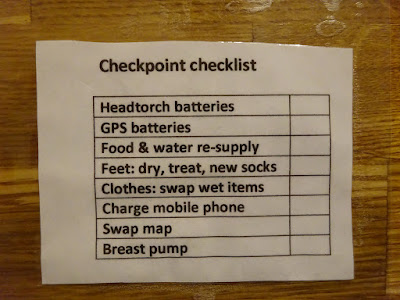 |
| Checkpoint To-Do's |
Knowing how tired I was likely to be in the later stages of the race, I laminated a list of essential Checkpoint To-Do’s, which included tasks such as ‘headtorch batteries’, ‘swap map’, ‘food and water re-supply’ and also now also ‘breast pump. I slotted this into the lid of my drop bag, which would be transported between checkpoints for me by the race organisation. Keen to limit checkpoint ‘faffing’ (in ultra-races, when one gets very tired, huge chunks of time can disappear without trace – I was determined to be either moving, eating or sleeping), I prepared food bags for each checkpoint, containing the required 3000 kcal of food, and trying to make this as varied as possible (in my experience, as one loses the desire to eat, variety is key to maintaining food intake – ultimately, it’s just fuel, and the body can’t keep moving forwards without it).
On the advice of my good friend Jim Mann, who’d run the Spine in 2018, I’d joined the Spine Facebook page for advice on gear, in particular my dilemma about socks. Whilst some answers were forthcoming (for example, permission to use the SOL emergency bivvy), I found the discussions somewhat overwhelming – everyone seemed so well prepared and had clearly been planning their blister-evasion strategies for months. In contrast, I had tested my socks (Drymax), and new shoes (Inov8 Roclite 275s with G-grip) only a couple of times, although I’d been running in the older version of the shoe all winter. My yes/no gaiter dilemma was decided on the morning of the race, when I asked a fellow competitor whether they knew how to attach them – he pointed out that I was missing the loops to do so, whereupon I vaguely remembered the elastic bits I’d left in the box in Scotland, assuming they weren’t important. Needless to say, I started without gaiters.
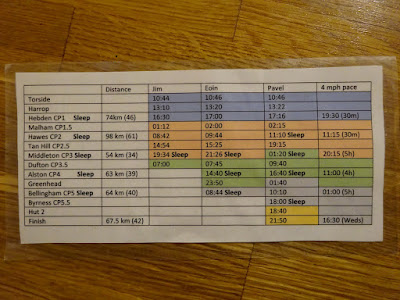 |
| Reference Splits (colour indicates day, times in parentheses are rest times) |
Having never run a non-stop race as long as the Spine, it was hard to predict how long it might take me. Looking back at the 2018 leaders’ splits, it seemed to me that their pace typically started around 5mph but dropped to half of that in the later stages. A more logical approach would surely be to aim for a steady 4mph throughout, with some solid blocks of sleep from checkpoint 2 or 3 onwards? With Konrad’s help, I drew up a vague plan along those lines, with the surprising but encouraging finding that this would have me arriving in Kirk Yetholm by Wednesday evening. Given that this would fall well within the course record, I suspected that it was probably overly ambitious (although ironically, my finish time prediction turned out to be fairly accurate, except that I ran more slowly, and therefore slept less in order to achieve it.
We spent the day before the race at my parents’ house in Hadfield (which lies at the edge of the Peak District – the moors of Bleaklow were the site of many childhood adventures), relaxing and seeing friends. Rowan slept badly that night, but she was fast asleep when I crept out of bed at 5.30am, heading for Edale and the start of the Spine.
Start (Edale) – CP1 (Hebden Bridge), 74km, 2,442m ascent
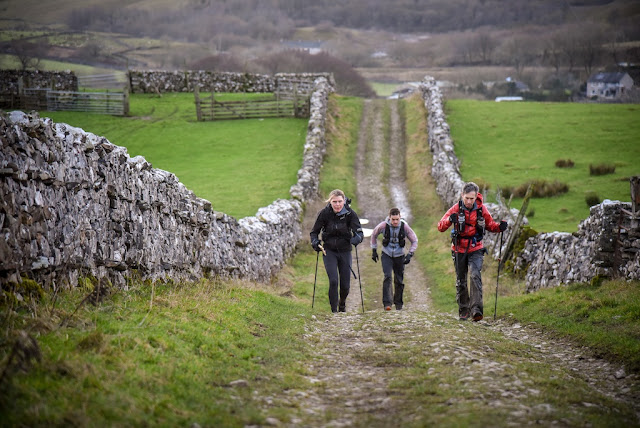 |
| (photo Mick Kenyon (Racing Snakes)/Montane Spine Race) |
At 8am on Sunday 13th January, still in semi darkness, we lined up for the start of the 2019 Montane Spine race. The weather was wet and windy, but not overly cold, any hope of frozen bogs had been abandoned. It seemed silly to push through to the front, given how far we had to go, so I started somewhere amongst the general mass, and gradually moved into the leading group. This contained the favourites for race victory – previous winners Eoin Keith and Eugeni Rosello Sole, alongside other strong contenders, including Jayson Cavill. Eugeni seemed unsettled from the outset, keen to be moving faster, and kept looking back from his position at the front, as if waiting for someone to make a move. I felt the pace was more than fast enough. As we reached the top of the climb up Jacob’s Ladder, Eugeni broke away alone, and disappeared into the mist in front. Based on previous races, it seemed unlikely that Eugeni would want to race the entire Spine solo from the front, and Eoin clearly felt this too, as he made no move to follow.
For the remainder of the day we ran into a strong head wind, which swung at times into a cross wind, but was rarely in our favour. The Kinder Downfall waterfall was blowing uphill in a great plume of white spray, and I began to question my decision not to start in waterproof trousers. Jason clearly did too, since he stopped to put them on, only re-joining us a couple of hours later, around Blackstone Edge. The rain started again, but along with it came a spectacular rainbow, a cheering sight after a day of grey. Eugeni reappeared, possibly recognising the value of company in the face of the wind. At dusk we passed the impressive Stoodley Pike, where the gusts threatened to knock us off our feet and started the descent to Calderdale. Without really noticing, we’d dropped several people, and by the time we pulled out headtorches for the final hour into the checkpoint at Hebden Bridge, it was just Eoin, Eugeni and myself. I started to worry that my achilles tendon was beginning to ache – a potential disaster at this early stage if I wanted to reach the end – and decided to collect my running poles from the checkpoint, to ease the load on my feet, just in case.
The descent to the checkpoint was steep and treacherous, wet with mud and fallen leaves. At the bottom, we emerged to lights and people, all eager to help. I’d expected we’d all go inside, but it seemed there was an option to keep our shoes on in the outer room, and this was clearly Eoin and Eugeni’s intention. Being keen to run in company for the first night if possible, I followed suit, seating myself in a corner and somewhat clumsily expressing milk with one hand whilst I shovelled down pasta and rice pudding (sequentially, not at once!) with the other. I smeared some Vaseline on areas prone to chaffing, thanked the fantastic volunteer staff, and headed after the others, whose lights were already some way above in the darkness. This was probably the only checkpoint where the expressing issue really cost me any time, and it was fairly minimal – later on my milk supply dropped (the body is pretty smart!), and it hardly took any time at all.
The first 46 miles had taken us 10 hours. In the course of the day, I’d eaten a scotch egg, a bagel with ham, several chocolate bars and biscuits, a banana (thanks to a stranger handing them – and the chocolate - out to us all), and a bag of homemade trail mix. I hardly saw the others eat anything, with the exception of the donated chocolate. Still, I felt it was better to eat whilst the going was good, since it would no doubt get harder down the line.
CP1 (Hebden Bridge) – CP2 (Hawes), 98km, 3,195m ascent
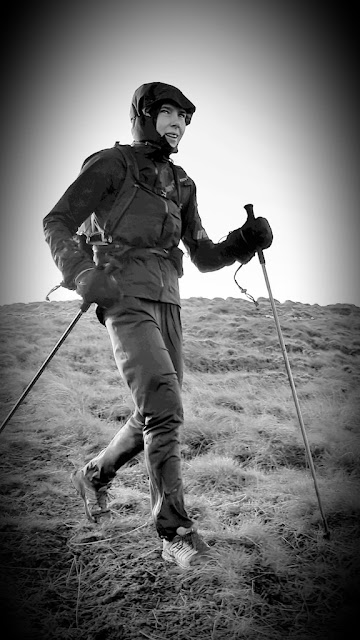 |
| (photo Mark Haywood) |
In many ways, the next section was the hardest part of the race for me. I was missing my family and worrying how bedtime would be progressing in my absence. Meanwhile, the darkness and winter had closed in tightly around us, and the occasional lights we passed only served to remind us how nice it would be beside a cosy fire, or indeed heading for a warm bed. With over 200 miles of racing still to go, I couldn’t really contemplate the finish line yet, so instead I tried to focus on getting to Hawes – or at least the intermediate checkpoint at Malham Tarn. To lift my spirits, I called home, but whilst doing so I dropped a glove and subsequently lost several minutes retracing my steps to search for it, necessitating a faster section of solo running to catch my companions.
I was very grateful for their company that night. Eoin in particular, had an aura of experience and calm about him, that made it all seem relatively routine. Once we’d started to chat, I also realised how likeable he was, and the next few hours passed remarkably quickly (conversation with Eugeni was harder due to the language barrier, but the feeling was very amiable). The wind had dropped now, so it was silent as we passed the moonlit Ponden reservoir, until a flock of roosting birds took flight over our heads. Climbing up to Ickornshaw Moor, we met some fell runners, who gave us chocolate and coffee, and a little while later – at Lothersdale – we feasted on Christmas cake courtesy of a local tri club.
For some time after that the terrain and gradient were nondescript, and sleep inducing, until we reached the slippery boulders marking the climb to Malham Tarn. Here we started to pass occasional Challenger Runners, although in my sleep-fogged state I didn’t work that out until later. At the intermediate checkpoint I drank a strong coffee and a hot chocolate, but still nearly fell asleep on the toilet. In retrospect, it seems odd that I should have been so tired on the first night of the race, but I explain it as my chronically sleep-deprived body trying to exert some influence on me – once it had given up, staying awake became less of a trial.
After that I started to feel better, especially on the climbs. We passed Fountain Fell and scrambled up to the summit of Pen-y-ghent as the sky turned pink with dawn. In Horton we stopped for a hot drink (and a slice of cold pizza from my pack in my case), before pushing on towards Hawes at a steady walk/jog, now in sunshine. Eoin had dropped back a little, and I remember Eugeni telling me as we descended towards the village “We go to supermarket, one minute!”, to which I replied with a laugh, “No, I’m going to the checkpoint to pump some milk, I’ll see you there”.
CP2 (Hawes) – CP3 (Middleton in Teesdale), 54 km, 1,871m ascent
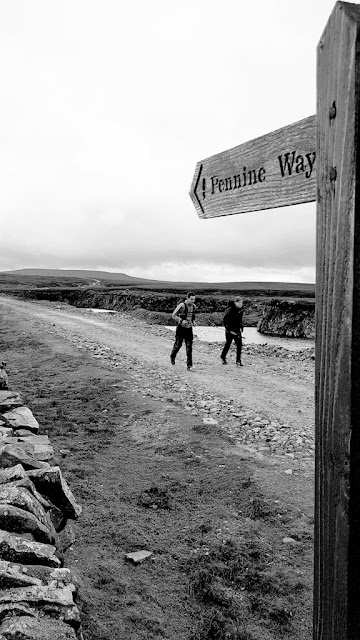 |
| (photo Mark Haywood) |
After cottage pie, tea and cake, I sorted out my kit, changed my socks and left. I was feeling strong, and keen to run on my own for a bit, so I pushed the pace leaving town. At Hardraw I ran past a group of supporters, and narrowly avoided a chicken – later I learnt that this photograph had afforded the chicken its moment of fame on social media – before starting the climb of Shunner Fell. It felt good to be running at my pace, and I had clearly opened a gap, seeing no chasing figure behind me as I reached the summit. Unfortunately for me, the descent was open and visible for miles, with straightforward navigation. As I feared, a small black figure appeared on the horizon behind me before I was out of view and was clearly trying to chase me down. I wasn’t keen to trash my legs with a fast descent, so I stuck with my pace and sure enough, as we reached the valley, I heard a long whistle behind me… I dropped my pace and waited for Eugeni to reach me. He greeted me with ‘Ok? All ok?” or something to that effect, to which I replied (not feeling overly delighted, although it wasn’t clear whether he realised this or not) “Yes, and you?”.
Thus, we continued together on the long climb up to Tan Hill Inn, arriving there just as it grew dark. In contrast to the exposed lonely moors outside, the inn was warm and inviting, full of good smells and company. I ate tomato soup whilst chatting to Liz and Jim, who’d come out to support the Spine, fresh from his win at the Challenger. It was hard to leave that place, and return to the dark, wet, boggy night outside, but the promise of a sleep at Middleton was motivation enough. We followed the white posts and stream bank through the famous bog, then wandered for some time through heather and tussocks before reaching Sleightholme Moor Road. The next section is rather blurred in my memory – dark boggy fields, then moors of the same quality. We passed under the A66, where a welcome box of chocolate biscuits was labelled with ‘Spine Runners, Go Go Go!’ (courtesy of Jim and Liz). A mist had descended, creating a speckled light show in the glare of our headtorches. At long last the lights of Middleton appeared, and we moved more quickly, keen for hot food, company and bed.
CP3 (Middleton in Teesdale) – CP4 (Alston), 63km, 2,002m ascent
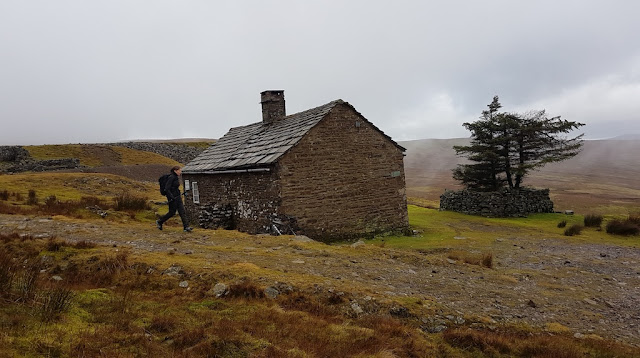 |
| (photo Mark Haywood) |
After fantastic chicken curry and more rice pudding, I attempted a short shower (not so successful, as the water was cold, but I was too tired to move into another one), washed my socks (I only had two pairs of the ones that I’d started in, and they seemed to be working, so I thought I should probably wash and dry a pair of them for later), and called home. Then I gratefully fell into bed, in my own room (the advantage of being a frontrunner in a race like this) which was wonderfully warm. I climbed into bed fully clothed, with my sleeping bag and 2 extra duvets - it’s amazing how cold one can get when tired. I’d planned to sleep for 3-4 hours, but in the event, I heard the checkpoint staff waking Eugeni around 2 ¼ hours later. I tried getting up, felt wobbly, and lay back down for a second short doze after which I felt better. Breakfast was porridge, and I had company – Eoin had just arrived. It was good to see him, and we chatted for a bit before he headed to bed and I went to pack. Eugeni left a little before me, I was happy to let him go as I fancied being on my own for a while.
I was in two minds about Eugeni’s company – in some ways it was really nice to have somebody to journey alongside, and share the challenges, and the joys. At the same time, I’d put so much effort into my Spine preparations, that I wanted an open race. Whilst I know Eugeni was capable of navigating (for one thing he had run the race several times before, for another he demonstrated it in the later stages), when running with me I sometimes felt like a personal guide, leading the way. Granted, he would occasionally shout out “Left!” or “Right!”, but ironically that didn’t always match the direction he was pointing (although to be fair, this particular feature was rather funny, even endearing). What probably irked me more, was his assumption that we were running as a team, against the rest of the field – this without me ever being consulted. As we approached Middleton for example, he told me emphatically “We must only sleep 1-2 hours, Eoin is coming!”, to which I replied that he was welcome to do as he liked, but so would I.
It was strangely easy to start out again, into the familiar darkness. The wind and rain had dropped, and it was that silent pre-dawn time when the world seems to become still. I jogged along, calculating my pace on the easy flat running to Low and High Force, and was surprised to find that even on this straightforward terrain, I was no longer managing the predicted 4mph I’d calculated on previously.
The rocks around Cauldron Snout were treacherously wet, and I slowed right down, aware of how easily a leg could be broken here (and given the lack of any reception, even for our GPS race trackers, one would wait a fair time for rescue). Climbing up towards High Cup Nick, the wind picked up again, and I stopped behind an abandoned hut to put on extra clothes, thick gloves and a hat. A murky light was coming through as I reached the top, where I wasted some time stupidly following my GPS trace down the steep ‘V’ of the ‘Nick’ itself, before using some common sense – and my map (!) – and starting along the dramatic edge, and down towards Dufton.
Eugeni was waiting for me beyond the village, presumably keen for company, so we joined forces again over Cross Fell (893m), the highest point of the race. The descent from the summit was a joy for tired legs, springy and forgiving. The famous ‘noodle bar’ at Greg’s Hut was disappointingly empty (this, and snow, are the two things I feel I missed out on in my Spine experience!), so we continued on, eventually reaching Alston in the late afternoon.
CP4 (Alston) – CP5 (Bellingham), 64km, 1,674m ascent
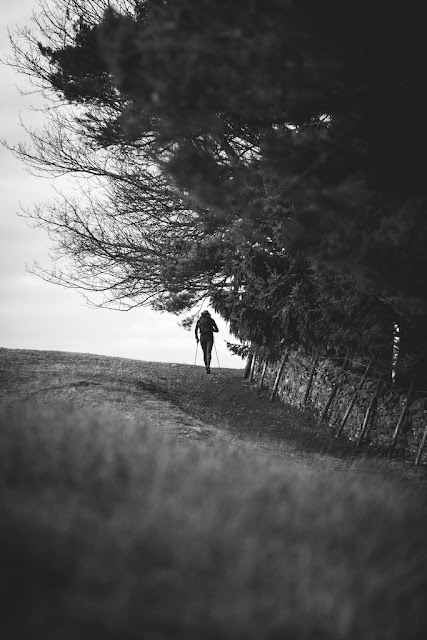 |
| (photo Yann Besrest-Butler/Montane Spine Race) |
I remember Alston as the site of the best lasagne I have ever eaten. I’d vaguely planned to sleep here, but as it was still light outside, and I was feeling ok, I decided to make a move. Eugeni had lain down and was having a massage – I think his legs and feet were giving him some trouble. He seemed to have fallen asleep in the process and didn’t make any sign as I prepared to leave. Seeing this as my opportunity to get away, I started with genuine purpose. I had roughly 1.5 hours of light and I needed to open as big a gap as possible in that time. I hurried along (although at this stage of the race, it was more of a stick-assisted jog), paying close attention to the race route in the knit of fields and farm dwellings that followed. At Slaggyford, supporters came out from their houses and offered coffee, as well as the welcome news that Eugeni had not yet left the checkpoint. Further along another supporter started to appear at intervals (Mark Haywood, I later learnt that he follows the Spine every year and I have him to thank for some excellent photos), clearly enjoying the race which was developing between Eugeni and myself. Darkness fell as I reached Hartleyburn Common. By now I had a roughly 7.5km gap on Eugeni, but he was definitely chasing! I crossed the A698, negotiated a fiddly bit in the fields, and then hit the frustratingly slow and waterlogged Blenkinsopp Common. Passing Greenhead and Thirlmere Castle, I reached Hadrian’s Wall. The gap back to Eugeni was holding steady, neither of us was making up time – it seemed a battle of the wills, waiting to see who would fold first.
Hadrian’s Wall was eerie and majestic in the misty dark. The short rises and drops were painful for tired legs, and demoralising in their repetition. In this dreamlike setting, the race with Eugeni was losing its intensity, and I struggled to keep some focus. I passed a group of supporters at a road crossing, and someone told me to stop and have a chat with a reporter – a request I ignored in the circumstances.
The section between the wall and Bellingham was a real slog. First bogs and endless forests, then moorland and muddy farmers’ fields. I was very tired, and struggling to stay awake, frequently I would trip up and wake myself just in time to prevent falling. My surroundings started to take on shapes of their own, and the dewy droplets that settled on grass blades and spiders’ webs shone out at me with a strange silver intensity, cutting rudely through my sleep fogged consciousness.
I tried singing aloud to keep myself awake; Spice Girl songs from childhood, and the ‘Woo Woo Woo’ train song from Rowan’s Bookbugs CD (when I hear this now, it still takes me right back to that final night). Later, I started talking to myself, kindly telling myself to put on more clothes and have some sweets – somehow the comfort of having a caring voice made it all less hard, even if that voice was my own.
The last few miles to Bellingham passed quickly. My mum and friend Alex had come out to see me on the hill, which was great for morale. I descended through a field to the sound of tribal beating (the source of which turned out to be a couple of costumed supporters behind a wall – I was beyond the point of finding this strange), and at long last reached the final checkpoint.
CP5 (Bellingham) – Finish (Kirk Yetholm), 67.5km, 2,146m ascent
Whilst I had not been certain I would sleep at Alston; I most definitely had planned to sleep at Bellingham. And yet, when it came to it, I knew that I couldn’t. Or at least I couldn’t if I wanted to stay ahead and try to win the race. I knew it was a big gamble – at this point I’d been racing for almost 3 days, with less than 3 hours of sleep, and I was falling asleep on my feet. But I also knew how hard I’d worked all night staying ahead of Eugeni, and I was fairly certain that if he found me at the checkpoint, he would stick with me to the end. So, I made the gamble. I ate, changed my clothes, and lay down for 40 minutes (I couldn’t sleep, but it was something). Then I drank a strong coffee and left, making my way quickly out of town so that my headtorch light wouldn’t be seen by the pursuer behind me. It was tough, leaving the warmth and safety of that place, but it helped to know that I was on the last leg, heading for my family, and my bed.The remainder of the night was cold, and surreal. I had a strong feeling that I was running with walls either side, but when I turned to look, there was just empty moorland blackness, and the sound of the wind. I got cold and stopped to put on more clothes, before stumbling on into a slow gray dawn. The forest tracks into Byrness dragged on, and I tried at one point to wake myself up by pressing down hard on a blister – this did the trick, but also left me hopping in pain for several minutes afterwards, the skin of my big toe having detached in the process.
The media team were waiting for me as I dropped into the valley, and Matt said by way of encouragement that many people had been sending inspirational messages, including one about two little girls tracking my progress. In my exhausted state, I found this rather emotional, especially in the context of my own little girl waiting at home, but it was good motivation, and spurred me on to start running again, albeit at a hobble.
At the halfway checkpoint of Byrness Forest Lodge I gratefully consumed hot mince and mash, before lying back in a chair whilst the volunteers kindly dressed my blister. The urge to sleep was strong, but I needed to get moving if I was to finish before night, so I forced myself up and out for the final leg over the Cheviot Hills to home.
That last day was very special. It was bitterly cold but sunny and clear – one could see for miles, all of it hills and wilderness. My mind was by now playing all sorts of tricks on me – everything I looked at changed into something else, typically something living and animal like. In the forest I passed a tree which bent down into the dog-down yoga position, before transforming into a deer, trying to shed its antlers. Once I reached the stone slabs of the Pennine Way, the shapes therein assumed the form of veiled nuns, or horses’ heads, and at one point I saw a bright pink pig running through the heather. These visions didn’t scare me particularly, I knew at the back of my mind that they couldn’t be real, and in some ways they were actually a welcome distraction. I also started to fall asleep again whilst walking along and would intermittently lurch into consciousness with a feeling of disorientation, questioning first where I might be, then realising I was running a race and panicking that I’d left the route.
Towards the afternoon it started to get bitterly cold, and I stopped in a sort of ditch (as much protection as one can find on the exposed tops of the Cheviots), where I put on every item of clothing I was carrying; two pairs of leggings, one pair of waterproof trousers, 3 base layers, one warm layer and one waterproof top, as well as thick gloves and hat. I tried to move as quickly as possible to keep warm, but I was getting increasingly weary and I’d also developed tendonitis running up the front of both legs, so every forward leg-stretch brought with it a sharp pulling pain.
The evening colours had started to soften into orange, gold, and then a dusky shade of pink blending into cold blue. It was breathtakingly beautiful, and I was aware even then that the memories of this final ridge run would last me a lifetime. I reached the junction for The Cheviot and paused for a moment, aware of its significance. As I started the descent from Auchope Cairn, the final hints of light retreated and the sky became a deep blue-black, scattered with thousands of stars.
My focus now was purely on getting to the finish and my family, I’d lost much sense of the race behind me. At Byrness I’d learnt that Eugeni had slept briefly at Bellingham, and that Eoin was further back, but I also knew I’d slowed down, and that the final miles would be painfully slow. I vaguely expected a head torch to appear behind me on the horizon at any moment, but felt strangely accepting of the possibility, knowing I’d given the race everything I had – if someone passed me now, they deserved to win.
A bright light was pulsing on the summit of the Schil in front, but my progress towards it was frustratingly drawn-out. Eventually, I could hear voices, and the camera crew appeared from the blackness in front. They followed me on the descent, no longer struggling to keep up as I ran (or more accurately now, ‘hobbled’) along. Eventually they peeled off, and loped ahead in front, leaving me alone again. The last few miles were agonisingly long – I tried to jog, but I might as well have been walking. The trees lining the road waved their arms at me mockingly, tantalisingly human-like in that silent darkness.
Finally, I reached the top of a small rise and saw the village of Kirk Yetholm spread out below me. I started to run, seeing the crowd of lights at the bottom of the green, and hearing the voices drawing me in. Those final moments were overwhelming – after the silence and solitude of the Cheviots, I was dazzled by this mass of people and flashing lights. Yet there was elation too, and relief. People were talking to me from all sides, then someone ushered me towards the wall, which I needed to touch to finish the race. Everyone was asking what I needed, a bottle of champagne was handed to me, and a medal – but I was interested in only one thing. And then they were there; Konrad handing me a confused looking, warm bundle of loveliness that was Rowan. She peered at me suspiciously from beneath her rabbit-eared woolly hat, and I sensed the potential for rejection, in amongst that crowd of strangers and lights. Quickly I pulled off my black hood and hat, pulling her close and hoping she could smell mummy beneath the layers of sweat and mud. To my relief, she turned to face me with a look of understanding, and all was well (although she waited to ask for a feed until I’d had a shower!).
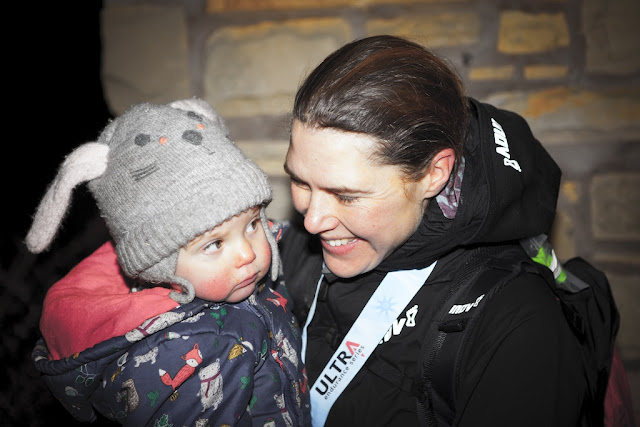 |
| (photo Yann Besrest-Butler/Montane Spine Race) |
The rest of the evening passed in a blur of warmth, clean clothes, food (fish and chips – I’d dreamed of them on my journey), and interviews. I was worried to learn that Eugeni had stopped at Hut 2, and that the race crew were going up to see if he needed help. It transpired that he had started to get irreversibly cold, and there was no choice but to rescue him, with only 6km of the race to go. I was desperately sorry to hear the news - the frustration of being so close to the finish after all that effort – but mainly just relieved to hear he was well and recovering in a warm bed. I’m excited to follow his race this year, and I’ll be holding my fingers crossed for him to have good luck and a cracking run.
The aftermath
I wasn’t really prepared for the media storm that would result from my run at the Spine. Ironically, the post-race days of family time I’d imagined as I ran were taken over by interviews from all sides, it seemed that everyone wanted to talk to me. Whilst the whole thing was rather overwhelming, I have also been touched and deeply inspired by the many messages I have received from people all across the world, telling me their own stories, and explaining that I have made a difference to their lives.
I didn’t race much for the remainder of 2019. It took me several months to feel fresh again, and even then, I kept picking up small injuries which probably indicated a deeper-seated tiredness. After a 3 ½ year hiatus (for a research PhD and maternity leave), I returned to part-time clinical work as a vet (the remainder of my time is still research focused), which in itself was a challenge. We published the paper of my PhD findings, and I submitted and defended my thesis, which was a great weight off my mind. In April we skied the Haute Route, from Chamonix to Zermatt, in June I raced on the GB team at the World Trail Championships in Portugal, and at the end of August we ran the Petite Trotte à Léon (PTL), with Jim and Konrad, a great adventure that I’ve written about in a separate blog.
As for the future, I won’t be racing the Spine this year, but I will probably be somewhere on Bleaklow to cheer the runners on their first day. I’ll no doubt feel some nostalgia, and maybe even wish myself in their shoes for a moment, but I can guarantee that I’ll make the most of my warm bed and toddler cuddles that week, when I head to sleep after the final dot-check of the night. Good luck!

